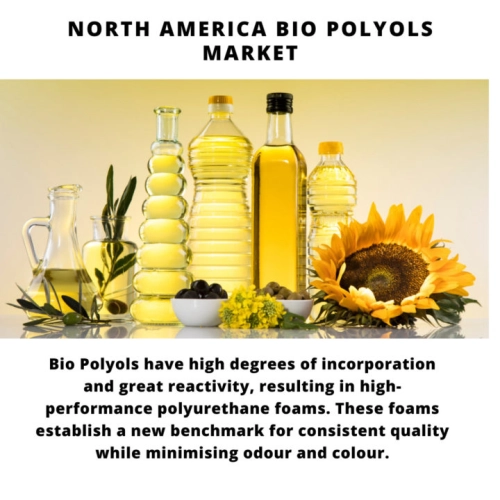
- Get in Touch with Us

Last Updated: Apr 25, 2025 | Study Period: 2022-2027
Natural oil polyols are bio-polyols derived from natural oils. Soybean oil, rapeseed (canola) oil, palm oil, castor oil, and sunflower oil can all be used to make polyols. The use of a certain natural oil might vary depending on the locale.
All-natural oil polyols have comparable origins and applications, however, the materials vary greatly depending on how they are manufactured. These polyols range in hue from colourless to bright yellow.

The viscosity of these polyols varies depending on the raw materials; it is governed by their molecular weight and the average amount of hydroxyl groups per molecule.
North America is also a dominant market because of advancements in sectors such as aerospace, automotive, and wind energy. Automotive, furniture, consumer durables, and other industries
The North America Bio Polyols Market accounted for $XX Billion in 2021 and is anticipated to reach $XX Billion by 2026, registering a CAGR of XX% from 2022 to 2027.
Cargill has successfully created biobased polyols for a variety of polyurethane applications, including the most technically difficult, flexible foams.
Cargill produces BiOHTM polyols by converting the carbon-carbon double bonds in unsaturated vegetable oils to epoxide derivatives, which are subsequently converted to polyols at low temperatures and pressures.
These polyols have high degrees of incorporation and great reactivity, resulting in high-performance polyurethane foams. These foams establish a new benchmark for consistent quality while minimising odour and colour.
Without the use of UV stabilisers, foams containing these polyols preserve their white colour for a longer period of time. In conventional testing, they also outperform foams containing just petroleum-based polyols.
BiOH 5000 polyol provides a broad processing window and enhanced performance in large slab stock foams such as those used in furniture and bedding.
| Sl no | Topic |
| 1 | Market Segmentation |
| 2 | Scope of the report |
| 3 | Abbreviations |
| 4 | Research Methodology |
| 5 | Executive Summary |
| 6 | Introduction |
| 7 | Insights from Industry stakeholders |
| 8 | Cost breakdown of Product by sub-components and average profit margin |
| 9 | Disruptive innovation in the Industry |
| 10 | Technology trends in the Industry |
| 11 | Consumer trends in the industry |
| 12 | Recent Production Milestones |
| 13 | Component Manufacturing in US, EU and China |
| 14 | COVID-19 impact on overall market |
| 15 | COVID-19 impact on Production of components |
| 16 | COVID-19 impact on Point of sale |
| 17 | Market Segmentation, Dynamics and Forecast by Geography, 2022-2027 |
| 18 | Market Segmentation, Dynamics and Forecast by Product Type, 2022-2027 |
| 19 | Market Segmentation, Dynamics and Forecast by Application, 2022-2027 |
| 20 | Market Segmentation, Dynamics and Forecast by End use, 2022-2027 |
| 21 | Product installation rate by OEM, 2022 |
| 22 | Incline/Decline in Average B-2-B selling price in past 5 years |
| 23 | Competition from substitute products |
| 24 | Gross margin and average profitability of suppliers |
| 25 | New product development in past 12 months |
| 26 | M&A in past 12 months |
| 27 | Growth strategy of leading players |
| 28 | Market share of vendors, 2022 |
| 29 | Company Profiles |
| 30 | Unmet needs and opportunity for new suppliers |
| 31 | Conclusion |
| 32 | Appendix |